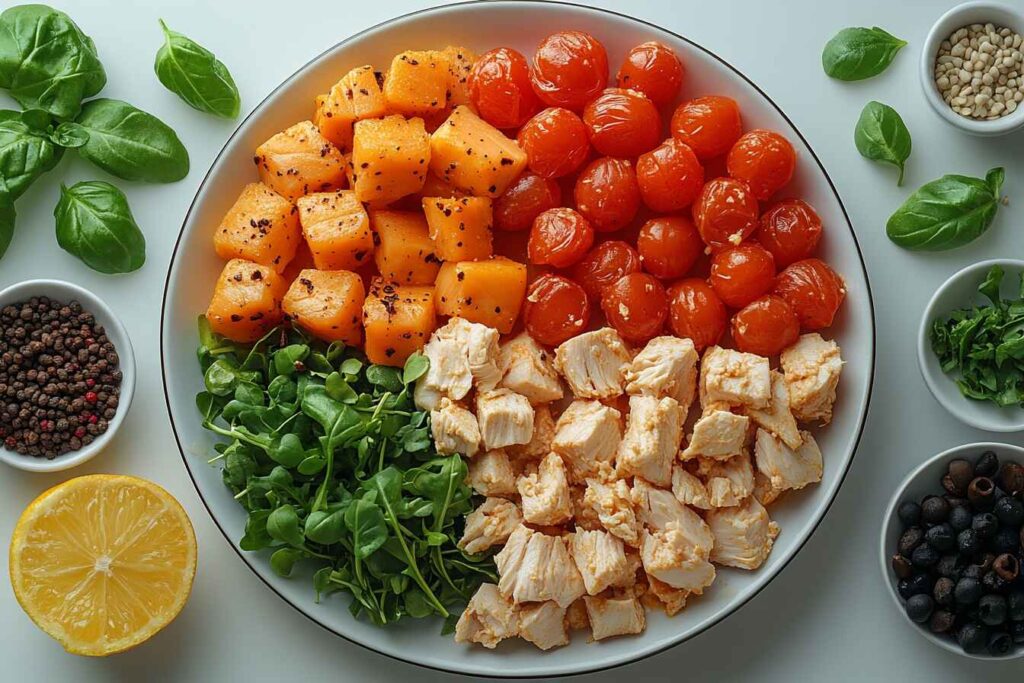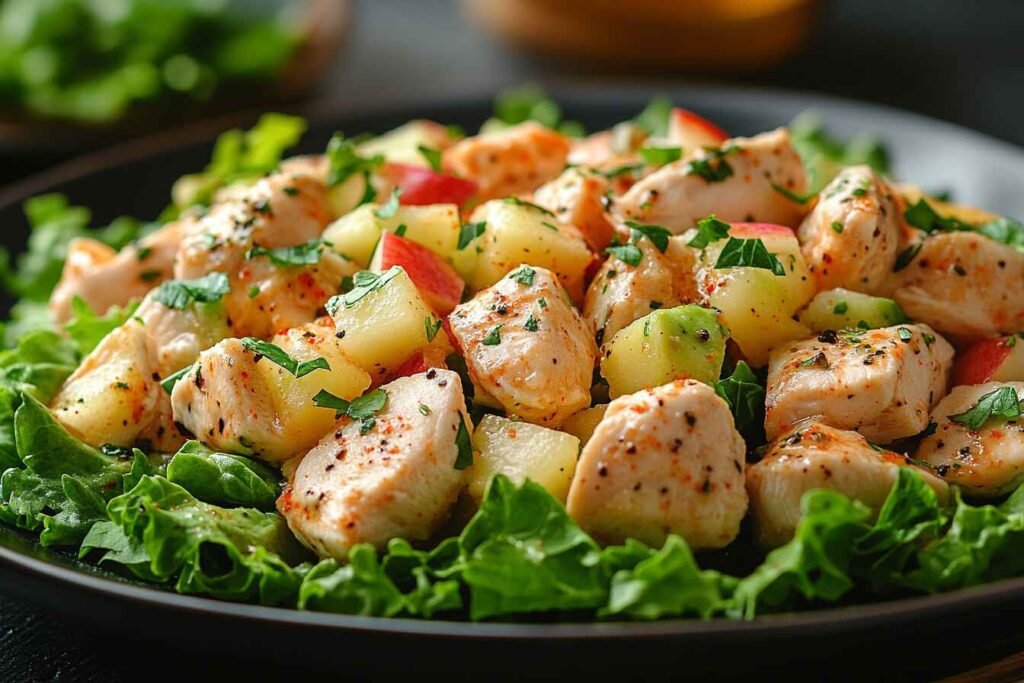When it comes to deciding between tuna salad and chicken salad, it can feel like a battle of taste versus health. Both are classic dishes loved for their versatility and flavor, but which one is better for your health? This article breaks it all down, diving deep into the nutritional facts, common issues, and tips to make either choice a healthier one. Ready to figure out which salad takes the crown?
Table of Contents
Introduction to Tuna Salad and Chicken Salad
First, let’s talk about what these salads actually are. Both tuna salad and chicken salad are creamy, savory dishes that can be served on bread, over greens, or even straight out of the bowl (no judgment here!). They’re easy to make, quick to whip up, and endlessly customizable.
Overview of Tuna Salad
Tuna salad is typically made with canned tuna mixed with mayonnaise, celery, onions, and sometimes relish or boiled eggs. It’s known for its rich, tangy flavor and its reputation as a protein-packed meal option. But is it as healthy as it seems? Well, it depends on how you prepare it.
Overview of Chicken Salad
Chicken salad, on the other hand, usually involves shredded or chopped chicken combined with mayo, celery, and a few other optional ingredients like grapes, nuts, or apples for added texture and sweetness. It’s a classic comfort food that feels fancy enough for a tea party but simple enough for a lunchbox.
Nutritional Breakdown: Tuna Salad vs. Chicken Salad
Here’s where things get interesting. Let’s compare the nutritional profiles of tuna salad and chicken salad side by side. Spoiler alert: the winner isn’t so obvious.

Quick Tip: The nutrition of your salad depends heavily on the ingredients you use. Small tweaks can make a big difference.
Calories in Tuna Salad vs. Chicken Salad
Let’s start with calories. On average:
| Salad Type | Calories per 1/2 Cup |
|---|---|
| Tuna Salad | 190–250 (depending on mayo content) |
| Chicken Salad | 200–270 (depending on added ingredients) |
As you can see, the calorie count is pretty similar, but adding extras like nuts or dried fruits to your chicken salad can make the numbers climb quickly.
Protein Content Comparison
Both salads are high in protein, making them great for muscle building and keeping you full. Here’s a breakdown:
| Salad Type | Protein per 1/2 Cup |
|---|---|
| Tuna Salad | 16–20 grams |
| Chicken Salad | 14–18 grams |
Tuna takes the lead here, thanks to its naturally high protein content. Plus, it’s leaner than chicken, meaning you get more protein per bite.
Fat and Cholesterol Levels in Both Salads
Fat can be tricky. While both salads are creamy and delicious, the type and amount of fat depend on the mayo (or alternative) you use:
- Tuna Salad: Typically lower in fat unless loaded with mayo. Tuna itself is naturally lean.
- Chicken Salad: Often higher in fat, especially if the recipe includes mayo, nuts, or creamy dressings.
Cholesterol levels also vary slightly. Tuna is naturally lower in cholesterol compared to chicken, so that’s something to consider if you’re watching your heart health.
Vitamin and Mineral Content
What about the vitamins and minerals? Both salads offer important nutrients:
- Tuna Salad: High in omega-3 fatty acids, vitamin D, and selenium.
- Chicken Salad: Rich in B vitamins, iron, and zinc.
Ultimately, the nutrient content depends on the specific recipe. Adding veggies, herbs, or seeds can boost the vitamin profile of either salad.
Common Ingredients in Tuna Salad and Chicken Salad
The ingredients you choose play a huge role in how healthy your salad is. Let’s look at the usual suspects and some healthier swaps.
Traditional Tuna Salad Ingredients
Here’s what you’ll typically find in a classic tuna salad recipe:
- 1 can (5 oz) of tuna
- 2–3 tablespoons of mayonnaise
- 1/4 cup of diced celery
- 1/4 cup of diced onions
- Salt and pepper to taste
Optional extras include boiled eggs, pickles, or a dash of mustard for extra zing.
Traditional Chicken Salad Ingredients
For chicken salad, a typical recipe might look like this:
- 1 cup of cooked, shredded chicken
- 3 tablespoons of mayonnaise
- 1/4 cup of diced celery
- 1/4 cup of diced apples or grapes
- Salt and pepper to taste
Some people like to add nuts, herbs, or even a touch of honey for sweetness.
Healthier Ingredient Substitutions for Both Salads
Want to make your salads lighter? Here are some easy swaps:
- Use Greek yogurt or mashed avocado instead of mayo.
- Add crunchy veggies like cucumbers or bell peppers for fiber.
- Skip sugary additions like dried fruit and opt for fresh fruit or herbs instead.
These small changes can cut down on calories and unhealthy fats while boosting nutrition.
Pro Tip: Use fresh lemon juice or a splash of vinegar to add brightness and flavor without extra calories.
Health Benefits of Tuna Salad
Tuna salad is more than just a quick lunch option; it’s a nutritional powerhouse if done right. Let’s explore some of the standout benefits of this popular dish.
Omega-3 Fatty Acids in Tuna
One of the biggest perks of tuna is its omega-3 content. These essential fatty acids are like magic for your body—they support brain health, reduce inflammation, and even help lower the risk of heart disease.
Did You Know? A single 3-ounce serving of tuna can provide up to 500 mg of omega-3s, depending on the type of tuna.
Low-Calorie Protein Option
If you’re watching your calorie intake, tuna salad is a fantastic choice. Tuna itself is naturally low in calories but high in protein, which means it keeps you full without packing on the pounds.
Pair it with a light dressing or skip the bread for an even leaner meal. Your waistline will thank you!
Important Vitamins and Minerals in Tuna
Tuna isn’t just about protein—it’s loaded with important nutrients like:
- Vitamin D: Supports bone health and boosts your immune system.
- Selenium: Acts as a powerful antioxidant, protecting your cells from damage.
- Vitamin B12: Keeps your nerves and blood cells in tip-top shape.
Health Benefits of Chicken Salad
Chicken salad has its own list of benefits, making it a go-to for health-conscious eaters. Here’s why it deserves a spot on your plate.
Lean Protein Source in Chicken
Chicken is one of the leanest proteins out there, especially when you opt for skinless breast meat. It’s low in fat and packed with amino acids, making it perfect for muscle repair and overall health.
Quick Tip: Shred your chicken instead of chopping it for a more tender texture in your salad.
Customizable Ingredients for Various Diets
Whether you’re keto, paleo, or just eating clean, chicken salad can be adapted to fit your dietary needs. Swap out traditional ingredients for healthier options like avocado or olive oil-based dressings to keep it fresh and exciting.
Low in Carbs and High in Nutrients
For those watching their carb intake, chicken salad is a lifesaver. By keeping it simple and skipping the bread or crackers, you get a low-carb meal that’s still satisfying and delicious.
Common Problems When Making Tuna or Chicken Salad
Let’s be honest: while both tuna and chicken salad can be incredibly healthy, there are a few common pitfalls that can derail your good intentions. Don’t worry; we’ve got solutions for all of them!
Excessive Calories from Mayonnaise
Ah, mayo—the creamy culprit behind those extra calories. While it makes your salad taste amazing, it’s loaded with unhealthy fats.
Solution: Use Greek yogurt or mashed avocado as a substitute for mayo. They’re just as creamy but way healthier!
Concerns Over Mercury Levels in Tuna
Tuna is a fantastic protein source, but it can be high in mercury, especially if you’re eating it frequently. Mercury exposure can be harmful over time, so it’s important to keep it in check.
Solution: Opt for light tuna instead of albacore—it has lower mercury levels. Also, limit your tuna intake to 2–3 servings per week.
Dryness in Chicken Salad
Ever had a chicken salad that’s dry and flavorless? It’s a common problem, especially if the chicken is overcooked or the dressing isn’t balanced.
Solution: Use poached or roasted chicken for juicier meat, and make sure to toss the salad with the dressing while the chicken is still warm. This helps it soak up all the flavors.
Tips to Make Tuna Salad Healthier
Now that we’ve covered the problems, let’s focus on making your tuna salad as healthy (and tasty) as possible.
Using Greek Yogurt Instead of Mayonnaise
Greek yogurt is like a superhero in the world of healthy swaps. It’s creamy, tangy, and packed with protein. Plus, it cuts the calories in your salad by more than half.
Pro Tip: Add a splash of lemon juice to Greek yogurt for an extra zing!
Adding Vegetables for Crunch and Fiber
Want to make your tuna salad more filling and nutrient-rich? Toss in some chopped veggies like cucumbers, carrots, or bell peppers. Not only do they add crunch, but they also boost the fiber content.
Choosing Low-Sodium Tuna Options
Canned tuna can be high in sodium, which isn’t great if you’re watching your salt intake. Look for low-sodium or no-salt-added tuna at the grocery store.
Tips to Make Chicken Salad Healthier
Chicken salad is a classic, but with a few tweaks, it can go from indulgent to incredibly healthy without losing its charm.

Opting for Grilled or Poached Chicken
The method you use to cook your chicken matters. Grilled or poached chicken is lower in fat than fried options, and it brings out the natural flavors of the meat.
Quick Tip: Shred the chicken while it’s warm—it’s easier and absorbs dressings better.
Mixing in Healthy Fats Like Avocado
Instead of loading up on mayo, why not mix in some avocado? It’s creamy, full of healthy fats, and adds a delicious twist to your salad.
Using Fresh Herbs for Added Flavor
If your chicken salad feels a bit bland, fresh herbs are the answer. Dill, parsley, or even a touch of basil can elevate the flavor without adding calories.
Did You Know? Herbs like parsley and dill are packed with antioxidants and vitamins, so they’re a win-win!
Tuna Salad vs. Chicken Salad: Best for Weight Loss?
When it comes to weight loss, the key is finding meals that are low in calories but high in nutrients and satiety. So, which salad wins in this department?
Comparing Caloric Density
Tuna salad is typically lower in calories per serving, especially if you’re light on the mayo. Chicken salad, while delicious, often includes higher-calorie ingredients like nuts, dried fruits, or creamy dressings, which can quickly add up.
To keep both salads weight-loss friendly, focus on lean proteins and low-calorie additions like veggies. Skip the bread or crackers and serve your salad over a bed of greens instead.
High Protein, Low-Fat Options
Protein is a game-changer for weight loss because it keeps you full longer. Tuna naturally edges out chicken here, thanks to its higher protein-to-fat ratio. But chicken isn’t far behind, especially if you use skinless breast meat.
Pro Tip: For a super light option, try a tuna or chicken salad lettuce wrap. It’s crunchy, refreshing, and cuts out extra carbs.
Tuna Salad vs. Chicken Salad: Best for Heart Health?
Heart health is all about balancing good fats, managing cholesterol, and keeping sodium in check. Here’s how these salads compare:
Impact of Omega-3s in Tuna on Heart Health
Tuna takes the lead here, thanks to its omega-3 fatty acids. These healthy fats are known to reduce triglycerides, lower blood pressure, and improve overall heart health.
Chicken, while a great protein source, doesn’t offer omega-3s. However, it’s still a heart-healthy choice when paired with wholesome ingredients and prepared without frying.
Comparing Saturated Fat Levels
The saturated fat content largely depends on the dressing you use. Traditional mayo can increase saturated fats in both salads, so opting for alternatives like olive oil-based dressings or Greek yogurt is a smart move.
Tuna Salad vs. Chicken Salad: Environmental Considerations
Beyond health, it’s worth thinking about the environmental impact of your food choices. Both tuna and chicken have pros and cons in this area.
Sustainability of Tuna Fishing
Some types of tuna are overfished, and certain fishing methods can harm marine ecosystems. When buying tuna, look for labels like “pole-and-line caught” or “sustainably sourced” to make an eco-friendly choice.
Did You Know? Light tuna (usually skipjack) is more sustainable than albacore or bluefin tuna.
Environmental Impact of Poultry Farming
Chicken farming has its own challenges, including high water usage and greenhouse gas emissions. Opting for organic or free-range chicken can help reduce your environmental footprint.
Conclusion: Which Salad is Healthier for You?
So, is tuna salad healthier than chicken salad? The answer isn’t black and white—it depends on your personal health goals, dietary needs, and even your taste preferences.
Choosing Based on Dietary Needs
If you’re looking for heart health and omega-3s, tuna salad might be the better choice. If you want a versatile, lean protein source, chicken salad has your back.
Balancing Health, Taste, and Sustainability
The good news? You don’t have to pick just one. Both salads can be part of a balanced diet when prepared mindfully. Focus on fresh, nutrient-rich ingredients, and you’ll win no matter which salad you choose.
Final Tip: Experiment with flavors and textures. Adding herbs, spices, or a squeeze of lemon can transform either salad into a culinary masterpiece!

